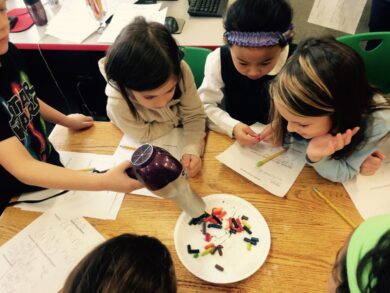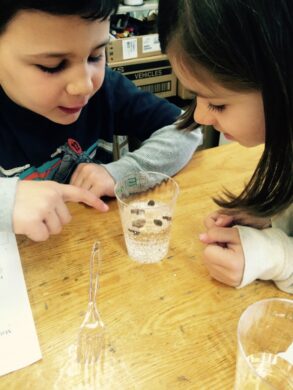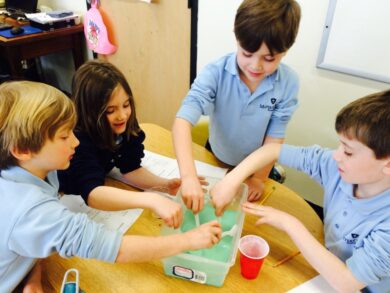 The first graders in Mrs. Sem’s and Ms. Barone’s classrooms at Mater Christi School recently spent two weeks studying matter as part of their science curriculum. They learned that matter is anything that has mass and that all objects are made of matter. Air, water, a brick, even they and their classmates are made of matter!
The first graders in Mrs. Sem’s and Ms. Barone’s classrooms at Mater Christi School recently spent two weeks studying matter as part of their science curriculum. They learned that matter is anything that has mass and that all objects are made of matter. Air, water, a brick, even they and their classmates are made of matter!
To help their students understand the concept that matter is made of particles existing in three states, namely solid, liquid and gas, the teachers involved the children in several experiments.
One of these required working with crayons. The students predicted that a solid like a crayon would melt when heat was applied. Some predicted it would stay in a puddle when cooled. They were surprised when the crayon hardened and they could break it into pieces and color with it. Seeing an object change its state and then return to its former state was intriguing.
 Dancing raisins was another experiment, and in this one, the children could see how matter when it is in gas form and invisible still has the power to affect other materials. The youngsters, after being told that the carbon dioxide gas dissolved in soft drinks gives them their fizz, were then let in on a secret! They could use the carbon dioxide fizz from a soft drink to make raisins dance.
Dancing raisins was another experiment, and in this one, the children could see how matter when it is in gas form and invisible still has the power to affect other materials. The youngsters, after being told that the carbon dioxide gas dissolved in soft drinks gives them their fizz, were then let in on a secret! They could use the carbon dioxide fizz from a soft drink to make raisins dance.
After pouring a can of clear soda such as 7-Up into a tall glass, the students noticed that the carbon dioxide bubbles were coming up from the bottom of the glass.
The children were instructed to drop 6 or 7 raisins into the glass and to watch what would happen. What they saw were raisins dancing.
 The students realized that raisins are heavier than the liquid in the soda, so they were not surprised when the raisins sank. They also knew that carbonated soft drinks release carbon dioxide bubbles –which tickle your nose when you are drinking the soda. To the surprise of the children, however, bubbles of carbon dioxide gas stuck to the surface of the raisins, causing the raisins to rise. When the raisins reached the surface, the bubbles popped, and the carbon dioxide gas escaped into the air, causing the raisins to sink. The raisins “danced” until most of the carbon dioxide bubbles had popped.
The students realized that raisins are heavier than the liquid in the soda, so they were not surprised when the raisins sank. They also knew that carbonated soft drinks release carbon dioxide bubbles –which tickle your nose when you are drinking the soda. To the surprise of the children, however, bubbles of carbon dioxide gas stuck to the surface of the raisins, causing the raisins to rise. When the raisins reached the surface, the bubbles popped, and the carbon dioxide gas escaped into the air, causing the raisins to sink. The raisins “danced” until most of the carbon dioxide bubbles had popped.
Some lengthy discussion and questions followed these experiments, but, actually participating in the process made for a series of successful and fun science classes for teachers and students alike.
Sister Joanne LaFreniere, RSM
Director of Public Relations and Spiritual Life
